(Words and Photos by Steve Magnante) – It all started innocently enough with a Friday afternoon bench racing session in my office at Hot Rod magazine. It was summertime in L.A., July 6, 2001 to be precise, and I was excited at the prospect of doing a little clandestine street racing in the Bad Seed Chevette later that night. After all, with its ideal 50/50 static weight distribution and 10-inch M/T slicks, it’d hook in a car wash, let alone on our little non-sanctioned test track on the outskirts of Los Angeles. Now before you freak out in disgust – or joy – when I bring up the topic of street racing, let me explain that my kind of street racing has nothing to do with the sensationalized carnage on the evening news or depicted (with hilarious inaccuracies) in Hollywood movies.
CLICK HERE TO READ THE MAGNANTE BAD SEED STORY PART 1
CLICK HERE TO READ THE MAGNANTE BAD SEED STORY PART 2
Our little group of acceleration junkies consisted of guys from all walks of life – including some cops and even a lawyer – who enjoyed getting together and “doing dangerous things…safely” within the closed confines of an industrial park in the aptly named City of Industry. Specifically, we ran on a half-mile long, four-lane-wide access road called Capital Avenue. There were no cross streets, no home owners to annoy with the sound of open headers and burning rubber and best of all there was a full ¼ mile of shut down space after the finish line was crossed. It was perfect and had been a hot spot for over a decade before I ever showed up with my Hemi powered Dart for the first time in 1998. Heck, if it’s not raining, they’re probably running there tonight.
Okay, with that out of the way, I was excited to see if the low buck Chevette could hold its own and put out an informal invitation to fellow magazine employees from Car Craft, Chevy High Performance to come along and watch. Whether any of these guys (plus one gal staffer in particular who was as race savvy as any of us dudes) was going to run their machines is best left to them to admit – or deny. For now, I’ll just say we all enjoyed plenty of late night bonding at Capital Ave. on other occasions. It was part of our job, at least that’s how I looked at it.
So as we’re chatting in my office, my recently promoted boss, David Freiburger walked in and one of the bunch said to him; “So Dave, are you going too?” “Where” asked David to which the response was; “To watch Steve race the Chevette at Capital Avenue tonight”. The silence was deafening. David turns to me with a very serious look and asks “Do you really think that’s a good idea?” In a panic, I blurted out a scramble of words that confirmed my intentions but stressed how safe the situation really was. I was busted before I even broke any laws! David concluded with “You won’t think it’s such a good idea when you’re ticketed” and left the office clearly upset.
An awkward and embarrassing hush fell over the group. Here’s some back-story to tell you why it was all so dramatic – and before I go on, I want to say right up front that I have deep respect for David Frieburger and his ability to run – and grow – any magazine he’s put in charge of. Whether it’s Car Craft, Rod & Custom, Four Wheeler or most recently Hot Rod, the guy has an unmatched ability to crank out monthly magazines that connect with readers. Despite some occasional friction (see below), I’d consider us pals – though we don’t hang out much these days since I moved 3,200 miles from L.A. to the wilds of rural Massachusetts in 2005.
With that said, let’s remember that when I was hired to be Tech Editor in 1997, my boss was the irreverent and (to me and many others) legendary Ro McGonegal, a man who I respect equally. Under Ro’s tenure as Editor of Hot Rod magazine there was a healthy unruly and reckless vibe that encouraged stuff like the Bad Seed Chevette. Take chances or die. I was in my glory. And if I happened to take in a little street racing on the weekend (from which I scored numerous feature and tech stories for use in the magazine), well that wasn’t something to be ashamed of. Heck, I sort of figured it was my duty to go into the battle field and come back with reports “from the front” – where guys were putting to use the hop-up tips they’d seen in the pages of Hot Rod.
But all of that changed suddenly. On Thursday, April 12, 2001 word spread quickly through the Emap-Petersen hierarchy that Ro’s time as Editor had come to an end – with David Freiburger arriving to replace him as Editor In Chief. The most stressful dimension was that Ro was still on staff, and I had deep allegiance to him and his ways. He’d been my boss for the previous four years and held dear many of the same things I did. There was a lot of loyalty. I liken it to a situation where a U-Boat suddenly gets a new Captain…but the old Captain is still on board. The crew is going to be confused. Though Ro was gracious in ceding authority to David, I harbored a lingering sense of anger over the deal – which I should have let go.
By the time of that July 6 office show down, David had been my boss for about three months. While we shared a mutual appreciation for Mopars (and getting as many as possible into the pages of Hot Rod), other aspects of our styles differed a bit. And so with his promotion into such a position of power, David had to react to news that one of his staffers was involved in street racing exactly as he did – by telling me no. I get that…now, some 12 years later. At the time I was deeply conflicted.
It all went like this: After the group in my office dispersed in a funk, David returned 20 minutes later with a really angry look on his face. He told me: “Taking the Chevette out street racing is a huge liability for the company”. Thinking more with my gas pedal than my brain I attempted to counter with: “But Dave, I own the car and have a title in my name so if anything happens, my ass will be on the line, not the company”. I was so sure our little street scene was safe I hoped he’d understand my logic – plus I’d already bought a bunch of expensive race gas to feed the 12:1 compression ratio in the Caddy motor and had no other use for it.
But David dug in further with; “You’re not hearing me. NO”. At this point, it was a show down and we’re both twitching with anger. For me, I was being told what to do and it stung. I wasn’t used to this. And from David’s point of view, I was being insubordinate and reckless. I realized that further discussion would likely end with my termination – which I wasn’t quite ready for. So I said: “Okay Dave, What I don’t want to do at this point is run afoul of your good graces. The car will not be used this weekend”. Looking back, I am still confused as to why my brain selected the goofy phrase “good graces” but that’s what I said. Anyhoo, we exchanged pleasantries then got back to the business of cranking out the latest issue of Hot Rod. But I knew my days were numbered.
To be truthful, it is a documented fact that most Hot Rod magazine staffers (Tech Editors, Feature Editors, Associate Editors, Editorial Assistants, even Editors) last about 3 years before moving on. They either get promoted to the Editor chair of a smaller magazine title, join the advertising sales team, get hired by the aftermarket as PR folks / copy writers or simply “burn out” and move on to other pursuits. But while you’re there, Hot Rod magazine is a fantastic stepping stone. It’s what you make of it, and I focused on making it fun. Guys like Marlan Davis, (the late, great) Gray Baskerville – and the highly respected David Freiburger – are the uncommon exceptions to the Hot Rod revolving door of recent history. They’ve managed to make themselves indispensable and have been rewarded with decades-long careers.
As for me, I served as Hot Rod Tech Editor for 8 calendar years (hired on Tuesday, August 19, 1997, resigned on Tuesday, January 20, 2004) and am proud to say I contributed to 77 issues of Hot Rod (cover dates December 1997 through April 2004), plus several additional articles as a freelance contributor in the years after my 2004 departure. From the start, I made it a point not to get involved with corporate or office politics. Again, I just wanted to play drums. I didn’t want to manage the band. Getting back to the Bad Seed Chevette, I stayed true to my word to David that the car wouldn’t be used that early July weekend.
But I didn’t promise anything about the night of Saturday, November 3, 2001. That’s when, about four months after the office showdown I trailered the little beast over to Capital Avenue for some safe and sane running. By this time, nobody on staff was sharing street racing stories over the water cooler and those of us who still played around did so quietly. A more conservative vibe had come over the place – driven in part by the fact the company got sold a few times and management heads rolled every so often. Worker ants like me were mostly safe from the axe, but again any late night street shenanigans were discussed off campus during lunch breaks on the other side of Wilshire Blvd. at Rocco’s Pizza.
I wish I could say the Chevette dominated the racing scene that cool November evening. Though it was hooking very well on the VHT-sprayed Captial Ave. starting line, I was defeated by 3 car lengths by “Jordie” in a sick small block powered ’64 Nova. Then an off-duty Sylmar police officer in a Chevy motivated Fox Mustang sedan zonked me to the tune of 5 car lengths. My seat-of-the-pants meter told me I was running low 12’s but these guys were up the ladder several rungs – they ran 10’s and 11’s at the strip.
But after the second pass, the Caddy 500 started pumping oil out the dip stick tube, making a mess of the interior – and my Simpson fire suit. Most likely, a ring land in one of the well-worn cast aluminum factory pistons had succumbed to the elevated (12:1) compression ratio brought on by the head swap. I was done for the night since the oil was also spraying the exhaust manifolds and causing a blinding smoke screen inside the car.
The threat of fire wasn’t my main concern since the engine was dead cold before each run (lots of waiting around between races on Capitol Ave.). The crankcase oil exiting the breathers was only warm to the touch and likewise, the stock Sedan DeVille exhaust manifolds were far from being heat soaked. The flash point of motor oil is simply too high for any of these heat sources to cause ignition. I’d have run it again but the wounded piston caused a miss and I was disgusted. We loaded the wounded Bad Seed on the trailer and brought it home to my place in El Monte.
In the end, the Bad Seed Chevette issue (April 2000) turned out to be a news stand bomb. The sell-through number was roughly 33-percent (compared to the 35 to 44-percent showing of a typical issue). You have to remember that the cover image of any magazine is the most influential element in making – or losing – a sale. I had plans for an overhead picture of the car, pirouetting wildly in a series of tight donuts. But the expense of renting a crane and lighting was too much for the monthly budget. As it was, the Bad Seed’s intimate engine-driver arrangement forced the rental of a fully-staffed ambulance to whisk me away for reconstruction if something went bad during magazine test sessions at L.A.C.R. / Palmdale. Had it not been for this additional $1,000 safety expense, perhaps more resources could have been made available for a more artistic – and compelling – cover shot.
Despite the meager setup, Gray Baskerville did his best to capture the nutty spirit of the Bad Seed, aiming his camera at the nose of the contraption emerging from a cloud of tire smoke with me at the controls, gazing through a bird shit smeared windshield. With fingers crossed, the cover design was approved by management and sent off to the printers for execution. Again, the news stand result wasn’t good. But it took several weeks for us to learn that sad fact.
In the meantime, the car was responsible for over 50 reader letters – with supporters outnumbering detractors by 10-to-1. But reader letters are a funny thing. More often than not, it is the vocal minority that tends to speak up. Meanwhile the silent majority pay the bills. Catering to a vocal few is risky business. But more significantly, the Bad Seed’s detractors included many advertisers and in-house corporate decision makers who felt the fast-for-cheap concept went a bit too far. In some camps, there was a sense that we were shaming Hot Rod’s legacy and reputation with such juvenile and crude antics. Perhaps. But let’s remember, it was the April 2000 issue, and April Fools pranks have long been part of the magazine trade.
After the Caddy 500 puked on that cold November evening, I lost interest and let it sit outdoors in my yard for ten months. I had my hands full with a series of projects like a nitrous-fed Slant Six Duster and three altered wheelbase creations. All the while, I knew the Bad Seed deserved a happy fate but was equally aware that it’d never be street legal in California (where V8 engine swaps are deal-killers). As for weekend drag strip use, I toyed with the idea of fabricating a quickie engine housing and firewall to get it past drag strip tech inspectors but somehow felt the entire premise of the car would be lost with the engine caged. So it continued to sit.
Long story short, I got the Bad Seed running again in 2004 and traded it to a buddy named Steve Benoit in exchange for rebuilding the 727 Torqueflite in my Stage V Hemi powered ’67 Dart. Steve is one of the guys from Bob Mosher’s Mopar Super Stock clone factory in Monrovia, CA. Though Steve had plans to make it legal for weekend bracket racing, it ended up in the hands of an unknown (at least to me) collector who brought it to the recent Hot Rod Homecoming at Pomona. Oddly, I have yet to communicate with the present owner but would be happy to talk any time. So there it is, the story of the Bad Seed Caddy 500 powered Chevette, one of the more infamous magazine project cars of recent times. Now you know the whole story! – Steve Magnante

Though the first Chevettes were sold in Brazil as 1973 models, the first U.S. built Chevette was completed on August 18, 1975. The main difference between ours and theirs was an increase in trunk size and a larger 1.6 liter four-popper to suit American needs. Though sized to appeal to Honda Civic and Volkswagen Rabbit buyers, the Chevette’s rear wheel drive layout makes it ideal for insane hot rod transformations – like the Bad Seed. This factory illustration reveals the Opel-derived live axle rear suspension. The stock curb weight was 2,155-lbs with front/rear weight distribution checking in at 55.2 / 44.8-percent.

The Caddy 500, Turbo 400 and Ford 8-inch rear axle swap increased curb weight by 353-lbs (to 2,508-lb, less driver). But thanks to a bunch of rearward engine relocation, the Bad Seed’s 2,740-lb. race weight (with my 232-lb girth aboard) was almost perfectly divided between the front and rear wheels. I made this drawing on Dec. 27, 1999. It depicts the result of a 4-wheel scale session at the (now-defunct) Evernham / Hawley Race Training Center in Irwindale, CA. Note how the front wheels carry 1,377-lbs versus the 1,362-lbs atop the rear drag slicks. This is the magic of engine setback. The resulting 50/50 front / rear weight distribution disproved the notion that V8 engine swaps in small cars always deliver nose-heavy pigs.
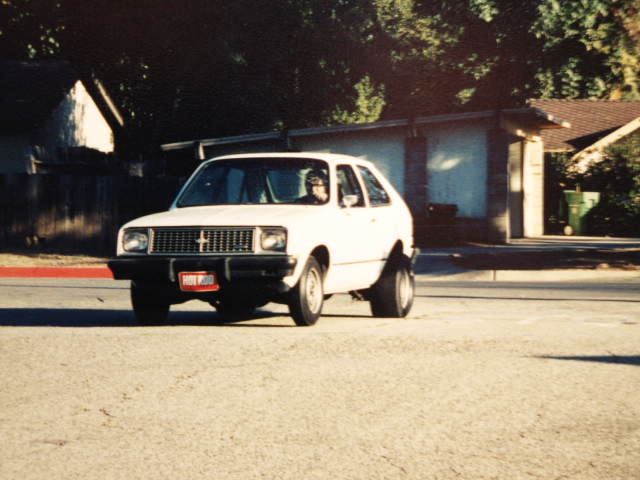
This shot was taken Christmas Day, 1999 on Cherrylee Drive, the location of my house in El Monte, CA. After flogging all night and connecting the usual loose ends, the Bad Seed ran and drove very well on its first outing. Thanks to the Caddy Y-pipe and muffler-equipped single exhaust outlet, normal folks inside their homes exchanged Christmas gifts without interruption. Note the wrinkled M/T slicks and fully extended front suspension. Tire spin was not an issue!
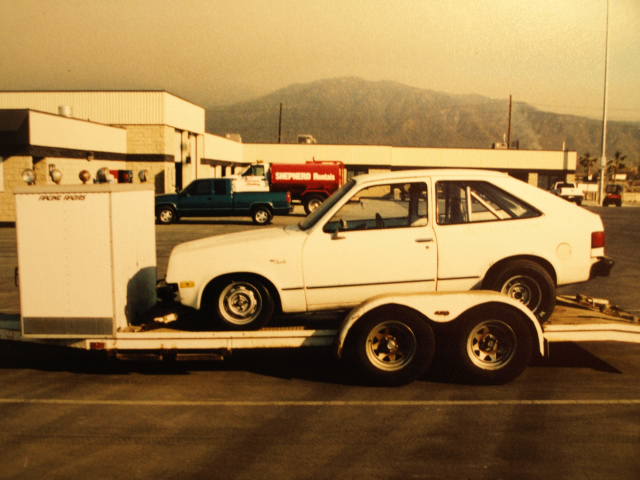
California’s smog laws are the strictest in the nation. Sacramento legislators have zero sympathy for monstrosities like the Bad Seed so license plates were out of the question. Other than brief test drives in my neighborhood, all daytime movement was done by trailer. Note the nose-down stance at rest. Though about 3-inches of clearance exist between the oil pan and road, a set of Chevette diesel front coils would have prevented many light scars. This photo was taken on Wednesday, Dec. 9, 1999, the day we trailered the car to the now-closed Los Angeles County Raceway (LACR) for magazine testing and to shoot an episode of Hot Rod Magazine TV.
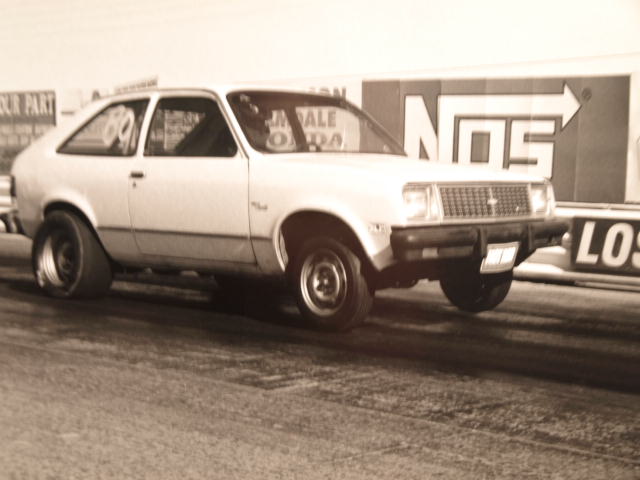
Despite promising street launches on Christmas Day, the LACR Chrondek timers and sticky VHT-prepped track would be the Bad Seed’s true acid test. Happily, the car made several low-twelve-second runs, the best being an un-corrected 12.33 at 107 with a “beastly” 1.666 60-foot time. Look closely and you’ll see an inch of daylight between the front tires and strip. Corrected for LACR’s altitude (and resulting thin air), the 12.33 was a solid 11.99 at sea level. The most amazing detail was how the Caddy 500 worked best when manually up-shifted at a conservative 4,500-rpm. I crossed the finish line at a mere 4,300-rpm! No doubt a switch from 2.80 to 3.08 gears would have delivered observed (as opposed to corrected for altitude) eleven-second e.t’s.

Several weeks later, we returned to LACR with a camera crew on Friday, January 28, 2000 to shoot “The Battle of the Vettes” episode for Hot Rod Magazine TV. By this time I’d replaced the muffler with a pair of side-exit straight pipes and added a Flex-A-Lite cooling fan. If you remember the old Hot Rod Magazine TV which aired on Speed Vision, the idea was to “bring the pages of the magazine to life and drive news stand sales”. So with cooperation from Corvette Mike (a big Corvette dealer from Anaheim, CA) we did a spoof show that first aired on February 25, 2000. Corvette Mike brought a ’69 427 Stingray, ’71 454 coupe, ’93 40th Anniversary Edition six-speed and a newer LS1 powered model. Each Vette was teamed up against the next until only the winner (the ’69 427 car) remained. At that point we rolled out the Hot Rod Vette…Chevette, that is. Thanks to the free breathing exhaust and Edelbrock intake manifold, the vintage Corvette’s mid-thirteen second blast was no match for my 11.99 pass. This time, there was no need to correct for altitude. I just remember the Chevette pulled an immediate hole shot on the big block Vette and I didn’t see any plastic for the rest of the ¼ mile pass. That episode of Hot Rod Magazine TV was titled “Battle Of The Vettes” and I still have a VHS copy floating around. It deserves be on YouTube but I don’t know what the lawyers would have to say about it…

Remember I said Ro McGonegal encouraged a creative vibe among his staffers? This photo appeared on the Table of Contents of the April 2000 issue of Hot Rod and says it all! I’ll forever be thankful for the experiences I had under Ro’s tenure. The plunger, Sawz-All, plush tiger slippers, lab coat and shorts just felt right on that chilly January afternoon in the high desert. And yes, I did wear a full Simpson fire suit when behind the wheel.

More tomfoolery, this picture was taken in my yard in El Monte. Visible here are the freshly painted Caddy 500, Pontiac Grand Prix-sourced TH400 transmission and stock 1,200-rpm stall converter, all poised to transform the Chevette into an acceleration monster.

Since I hadn’t yet learned how to weld, I hired my neighbor Dale Kutsch to handle the non-bolt-on elements of the conversion. One day he surprised me with this improvised driver retention system, a hastily converted ball hitch. In reality, a 5-point Simpson driver harness ensured safety. The simple bucket seat bottom was formed from steel sheet though the stock upright section (stripped of all padding) was recycled from the Chevette.

During a Sunday morning tour of the San Pedro self-serve auto wrecking yards with my then-co-worker Terry McGean (now Editor In Chief at Hemmings Muscle Machines), I found this radio delete plate in a crusher-bound Scooter. I had to have it. Since the Bad Seed’s stock dash and cowl configuration was eradicated by the rotary axe, a simple pair of metal strips secured it to the cowl reinforcement cross member. The motto is a nod to a popular song by the Smiths.

When I took delivery of the Chevette from Ecology Auto Wrecking on Sept. 17, 1999, these paper documents were created – assigning ownership (and legal responsibility) to me – and not the publishing company. My at-the-time boss Ro McGonegal wisely wanted it this way to create a legal buffer (me) between the car and the company. In fact, most magazine project cars (with rare exception) are the property of a staffer – not the magazine itself. But when David Freiburger replaced Ro as Editor, he wasn’t immediately aware the car was mine. He assumed the nasty little critter was company property. It’s no wonder he freaked out at the idea of me running it on Capital Avenue.
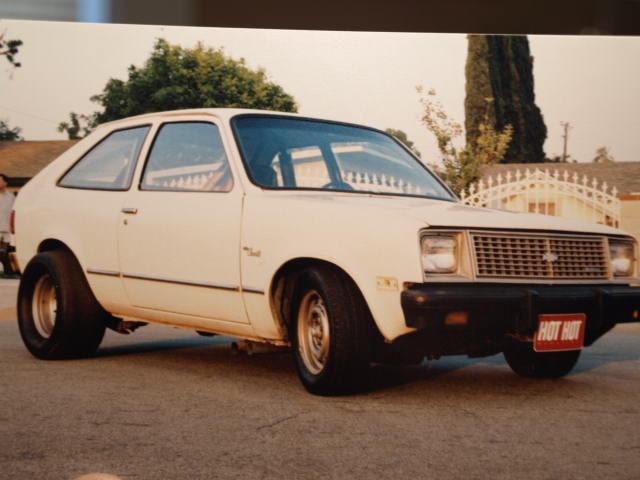
I purposely retained the stock 13×4-inch front wheels but replaced the cheap radials with a set of nifty BF Goodrich P155/80 B-13B55-13 bias-ply front tires I scored in the bone yard for $24. Out back, the Ford Mustang II rear axle’s larger non-metric 4-on-4-1/2 wheel lug pattern was matched to a pair of custom made 13×7 steelies based on Ford Escort center spiders. Classic Wheel Workz of Glendora widened the wheels to suit the M/T 24.5-9.0×13 import car drag slicks.

Okay, here’s the picture that would have gotten me sooo fired had David seen it at the wrong moment in time. This was the Bad Seed’s first (of only two) full speed passes it ever made on the street. Had the piston not collapsed a ring land, I’d have run it until the stock 12.5 gallon tank was dry. Capital Ave. was that safe and secure. Dig the fully VHT-prepped surface. Today, we can all laugh about it. Right Dave? (please say yes).
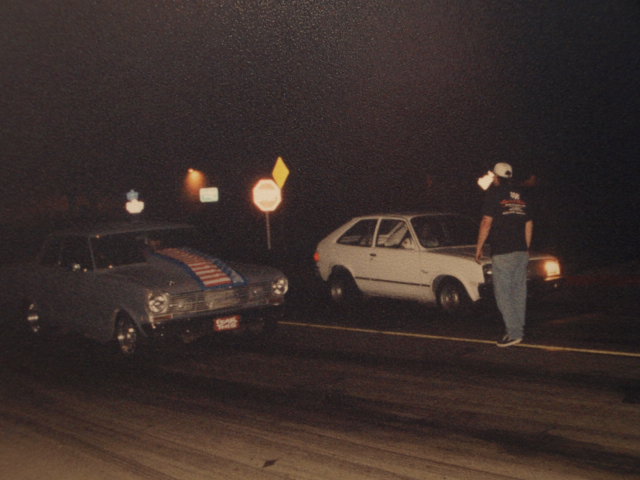
Shot by another camera from the other side of the street, the Bad Seed hooked without any spin and managed to pace Jordie’s Nova for the first few hundred feet. But by 500 feet, Jordie’s potent 406 small block began to march away and put a few car lengths on my by the 1320-foot finish line. I rigged up a simple wire from the alternator to the single headlamp for this rare night time outing. A thriving business district by day, Capitol Ave. is dead at night and so has few street lights. The Cyclops light helped illuminate the finish line cone as I blew past at 106 mph – with a full view of the Nova’s tail lights in the distance ahead.

Having long since moved onto security work in the Washington D.C. area, I can reveal that former Car Craft staffer Marko Radielovic was a frequent partner in my various crimes of non-sanctioned acceleration. Marko worked under the editorship of Matt King, who’se now a big wig at Harley-Davidson in Milwaukee.

After wounding the first 500, the immobilized Bad Seed became a lawn ornament in my El Monte yard. But through it all, I never once thought of junking the car. Note the Trans Dapt gas pedal has an improvised return strap made from a hose clamp. This was added after a sticky throttle cable held the engine at half throttle on one early test drive.
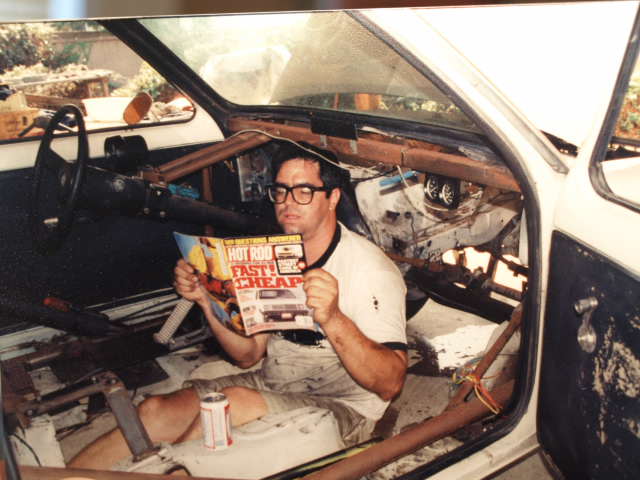
Yours truly takes a reading break during the reassembly of the car in August of 2002. Rather than repair the damaged 500, I returned to the junkyard and snatched a healthy but stock 472 from a ’73 Caddy. I just wanted to return the car to running condition so I didn’t bother to swap heads for extra compression. The rare one-year-only 1970 Caddy “950” small chamber heads were sold on eBay and the wounded 500 short block went to the scrap pile at my local Pick-A-Part. I didn’t know it here, but David and I found peace and I still had another two years to go at Hot Rod before my resignation in early 2004. I left to host a TV show called Classic Car Restoration on the DIY Channel.
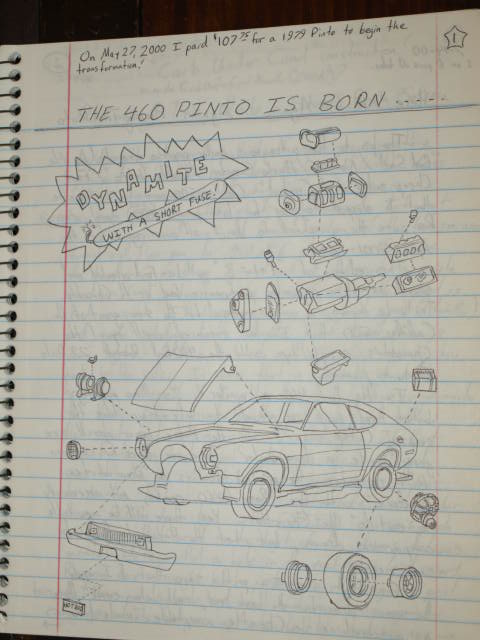
Encore! Encore! Before the disappointing news stand sell-through numbers and negative management / advertiser backlash generated by the April 2000 issue had come to light, I got initial approval from editor Ro (McGonegal) to build a Ford-based team mate for the Bad Seed Chevette…the Poison Pinto. The idea was to do the same mid-engine V8 conversion using a boneyard-sourced Pinto and 460 from a Lincoln Town Car. I whipped up this drawing in May, 2000 as part of the program pitch to Ro, who gave initial approval

Though custom wheels and flashy paint might have added eyeball appeal and played into the April Fool’s gag, I didn’t want to dilute the underlying message of making something out of nothing. X-ray glasses would reveal that the entire engine is located behind the front axle centerline. I spent my 36th birthday (July 14, 2000) rendering this image of the proposed Poison Pinto. Though the Pinto is larger than a Chevette and weighs 587-pounds more (Ford marketing called it “extra road hugging weight”…seriously), I was sure the 460’s inherently more stable valve train would allow crank speeds of 6000-plus rpm and deliver more power than the Caddy with similar budget mods. Remember, the stock Caddy 472 / 500 has trouble hitting 5,000 rpm due to its valve train. Would a higher-revving 460 deliver more power? Sadly, magazine budget cuts killed the project before we could explore. Further ambitions called for a Mopar-themed take on the combo for the April 2002 issue using a Dodge Colt and mid-mounted Chrysler Imperial-sourced 440 wedge. Oh, what might have been.
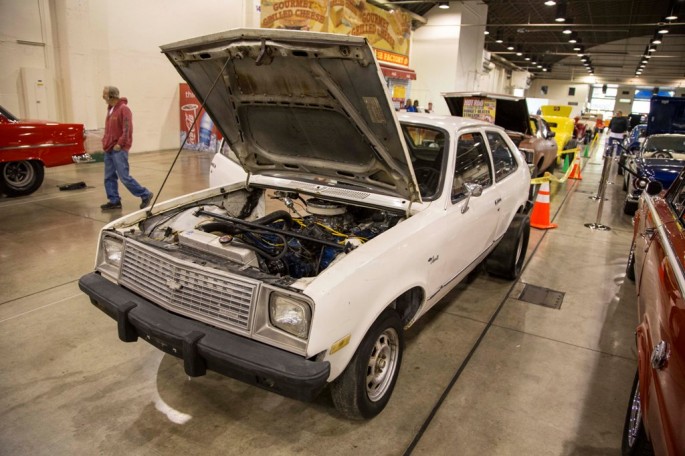
Seen here on display at the Hot Rod Homecoming car show on March 24, 2013, I was amazed that over thirteen years have passed since it was first conjured over beer and pizza. Long Live the Bad Seed! If the current owner wishes to contact me, I’m all ears! Please reach me through BangShift.com or at [email protected].













Great story Steve………..remember when the issues came out and i still have them………this is the kind of hotrodding i loved and still do……..its a real shame the pinto and colt never got built, they would have been awesome to………….
I remember Marko would be in and out of dippy.org when he built the “Stealth Bomber” Diplomat for Mopar Muscle. Didn’t quite pin him for a street bomber, though. From what I’ve heard from the guy who bought the Diplomat from him, I’m sure Marko was having a blast with that beast, too.
Great story Steve – Long live The Bad Seed!
Loved this car. I just wish I was in a position to replicate something like this back then. Even as recently as 10 years ago my brother and I were sizing up a Chevette at a wrecking yard that was selling out. There was even a 500 in caddy sitting in the corner right next to a smog based 454. Even with memories of the Bad Seed dancing in our heads, $50 for the motor and $50 for the Chevette we passed on the concept. Still regret the decision.
great story Steve! this is where me and my friends started, by trying to be faster than the next guy. put a bigger motor in it! we put Windsors in Falcons and 409’s in Chevy II’s. the best was 401 Nailhead out of Mom’s wrecked Wildcat into a 56 chevy 1/2 ton. not a lot of speed, but you could burn the tires for days.
Part III was definitely the most interesting part of the saga.
It would have been embarrassing to get canned by a guy wearing sandals. And the irony of a guy who used a hose clamp for a transmission mount (not to mention all the recent made-for-tv “Roadkill” hijinks) worrying about “liability” is rich.
DF wouldn’t be the first dirtball rodder who was corrupted by fame and “corporate responsibility.” Still Magneto reveals a side of DF that most of us haven’t seen.
I wasn’t a fan of “the Seed” when it ran in HRM because it pegged my “unsafe” meter . . . and it didn’t have any turbos or a Ford mill (besides, why build a rod that’s not legal to run on the street OR strip?)
But the caterwauling of the advertisers and the “suits” had to make the whole enterprise worthwhile in retrospect.
Now the only rebellion left in the “cube hive” is wondering how many leaf blowers to use. Kinda “low-T” now, isn’t it.?
I find it interesting that back then Frieburger had such a stick up his backside compared to now and the antics he performs on camera for Hot Rod’s “Roadkill” video cast.
In Dave’s defense street racing would be about as good a premise for a magazine story as dog fighting or offshore banking. I remember loving these articles but in retrospect, without performance numbers, like a dyno or a track, it’s hard to see how it could have moved issues to the masses who flip to the last page of every story for the peak HP or ET figure (which also looks good emblazoned across the top of the cover).
Loved this wacky car when it was built, just BECAUSE it pissed off advertisers and guys like DF!
Amazing story. Thanks for sharing. This is one of the very few issues of Hot Rod I have kept. It is one of my favourite magazine cars. Not that I would ever build one, but this projects heart was in the right place make it go with what you have. I am however totally shocked that you and Dave did not get along more – I figured you would have. That part of the story was amazing.
I remember DF at Car Craft with Matt King and their goofy antics, so I was confused when he moved to helm HRM. Suddenly, he was all milque toast. What the hell? It was if he was told his new position was based on him not bringing those antics to HRM. I was let down by the lack of hilarity in his first few years running the mag. I literally laughed out loud reading CC every month when he was there.
One glimmer of hope was when he took a junkyard 350 and nitro through it to see if it would blow up. It didnt blow because he only went up to 15% nitro. As I read the story I was thinking he was weeniefied by his new position of responcibity because I was sure if he wrote back.at his time at CC, that engine would be eating 85% nitro until they were picking schrapnel out of the walls.
Someone mentioned I was bashing David above. Nothing could be farther from truth. I was stating from a reader and fan’s point of view that I was confused by the change in tone in his editorial when he moved to HRM. As a fan of his work at CC I was disappointed.
At the expense of sounding like a dorky fan, I can honestly say no other editor of any magazine held my attention with their story telling like he has.
Agreed Scott. I’ve only followed him since 2007 (some gear head I am! Ha!) and it looks to me like he prefer’s the loose reigns as well. I know I like the antic’s, write ups and videos.
Excellent tell all there,
Thanks Steve, great read your story. What kind of shit are you working on now? And I mean that with alot of respect.
Hot Rod and Car Craft were things I looked forward to in my teenage years of the late 1990’s. Car Craft was great when Mr. Freiburger was the editor, and Hot Rod was fantastic under Ro’s tenure. When those things changed they both became less interesting. Dave was not the same working under the HR banner. I don’t know why, but creativity suffered for both publications following this move.
I’m remembering sleeping with the cats; pizza and two Cokes at… what was that hangout? … and nights at Capital. Those were the days!
-dulcich
Glad I caught the final installment of the “Bad Seed” saga.
Never in a million years would’ve guessed that DF, of all people, would’ve been the wet blanket in all of this. Particularly given his prior shenanigans(say it again!) at Car Craft, I would’ve figured it’d have been a madhouse of fun(such as with the days of CJTV and his Roadkill episodes). In his defense, I can see where the heavies threatened DF with his job if anything less than advertiser-friendly was to leak onto the pages(too many publishing-company ownership changes went down back then).
Does give me a whole new respect for Ro McGonegal. Thanks for putting this out there, Steve….looking forward to more stories here!
I knew Marko when he was at George Washington U. in Washington — have looked, but he’s not on Facebook. Do you know how I can get in touch with him?
Thanks.
I liked the Bad Seed Chevette a lot. It made me want to do bad things to my parents ’81 Subaru wagon, with a mid-engine 500″ Caddy engine/trans. I never did it, and I’m sure it would have been completely unsafe, but it would have been fun. I could always relate more to stuff like this, and the 440 Dart with the hose-clamp trans mount better than the mega-dollar stuff that usually makes the cover.
I relate Freiburgers & Finnegans “RoadKill” to the “Bad Seed”. The Chevette was never driven on a known public street, while almost every one of F&F’s video projects brag & I quote: “No tags, no registration & no insurance”. Sure I love “RoadKill”….what gearhead wouldn’t, but HOW do they get away with driving vehicles in such crappy, illegal condition, on LA freeways…..double standard maybe??!!!!
I think its great to see cars like this that was not built with sponsors……..almost no name speed parts and made it in hot rod…….almost seems like the aftermarket is killing “back yard hot rodding”
Concerning whether or not the aftermarket is killing ‘backyard hot-rodding’, there are actually a number of factors affecting what’s killing off this particular demographic, primary among these factors being that Detroit hasn’t produced an easy-to-mod car since the 1989 5.0 mustang…and that car was a freaking heap to begin with (I’ve owned eight Fox bodies). Unless you build a truck…there are no longer any RWD chassis platforms that are inexpensive to build hot-rods out of, most everything has gone FWD. I’m screwing around with late-model RWD Thunderbirds, but even then the level of half-assed automaker engineering is staggering.
The funny part is that the aftermarket, who pays the bills of the magazines in particular, are also killing off the magazines themselves, as more people revolt from print magazines in particular, especially those who can’t seem to find anything to write about other than Popular Hot-Rodding-based, blank-check builds, in which barely anything trickles down to the guy who doesn’t quite have two-hundred grand to spend on a toy.
You know we had two of these little “vettes” and to be honest we actually enjoyed them. They had as about much power as our lawnmower but they were tough and fun to drive. When I got the first issue of the Bad Seed in the mail we still had our second “vette.” I always wanted to drop some mean little motor into it and go just because I saw it in Hot Rod. Steve had always influenced me. I always wanted to build our “vette” in a gasser style. Tube axle, wide meats, radius wheel wells and some stacks through the hood. Of course red tinted glass as well.
I remember reading that issue when I was in high school. I thought it was the coolest thing ever. I also watched the hot rod magazine tv episode and loved it. There was a burnout at the end of the episode that I wish someone would upload to youtube because I only saw it once and it was glorious.
Bad seed was great.. the what if.. take the muscle car mantra of small car and big car engine.. and put them together.. loved that saga in the mag.. THE D/F being the killjoy.. might have been more the ownership turnovers and him being “new” to the king of the hot rod mag world..
What the suits would let fly then, isn’t the same as now.. so comparing road kill, or his car craft days, isn’t really fair.. Sometimes Suits don’t “get it” and you have to do as they say until they see you are moving the mag in the right direction.. and then you get a little more freedom.. As for road kill and them “claiming” no tags/etc.. remember it’s T.V. just cause there isn’t a tag in camera view ,doesn’t mean a thing.. Sadly, until the aftermarket changes and see’s that the junkyard crawl builds go hand and hand with builds that use their goods. mags, and even internet forums.. will suffer.. They have to understand not everyone will be able to buy their junk ,every time.. but those that do start with a dirtball build.. tend to move up the latter into builds that use their parts… it’s the old story.. hp, some is good ,more is better and to much just right..